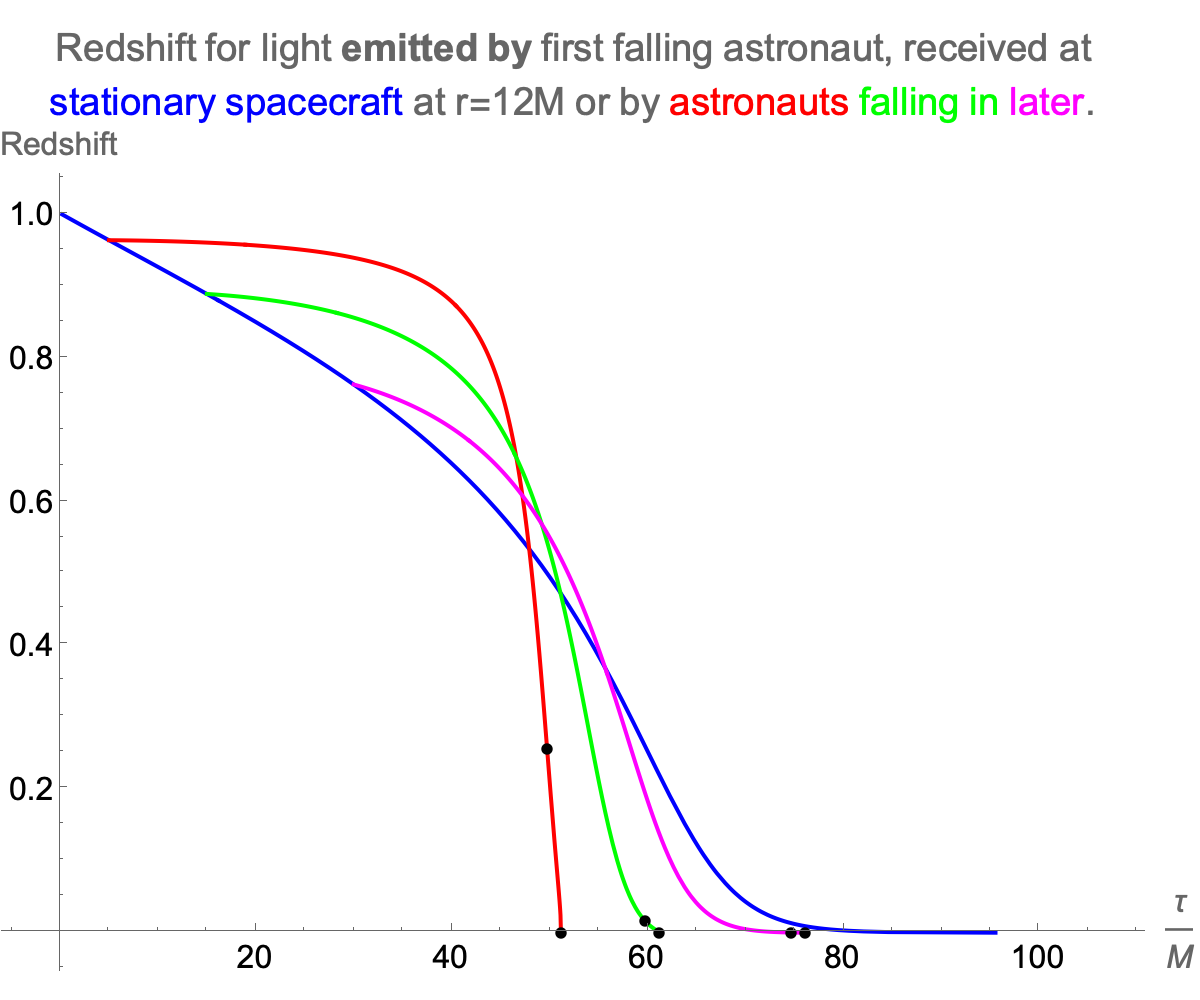Greg Egan on Nostr: Your spacecraft is using its engines to stay a fixed distance from a black hole, when ...
Your spacecraft is using its engines to stay a fixed distance from a black hole, when your friend, who was unwisely taking a spacewalk, snaps their tether and falls towards the hole.
[This is a thought experiment where the hole is large enough that its tidal forces don't instantly kill anyone who gets close.]
If they are carrying a light, you will see it grow increasingly redshifted as they fall towards the event horizon, and appear to slow down. The blue curve in the diagram plots their redshift over time, as seen from the fixed spacecraft.
Ideally you would swoop down in the spacecraft to rescue them (and although they seem frozen, you only have a finite time in which you could do that.) But suppose, instead, you decide to jump down after them. What effect would that have on the redshift you measure for them?
The red, green and magenta curves show how the redshift would progress if you did that after various delays. The two black dots on each curve mark the points where you would pass through the event horizon, and when you would hit the singularity. When you cross the horizon, the light you will see from your friend will have been emitted at precisely the moment when *they* crossed the horizon.

Published at
2024-11-27 10:49:23Event JSON
{
"id": "cdc81eb90232c13d104f73e97d0f1c3e1f585146964fdcc292ccd4629a7c2a5d",
"pubkey": "0037e9f1404aa866c76ed1358206ac5387eb2d3589361a3802af0f260bda26d7",
"created_at": 1732704563,
"kind": 1,
"tags": [
[
"imeta",
"url https://media.mathstodon.xyz/media_attachments/files/113/554/523/876/309/620/original/45039b4d71d62717.png",
"m image/png",
"dim 1200x1000",
"blurhash U4S?DWD+yCj@9FD,Rpoa00kEohRPIUR.tRV?"
],
[
"proxy",
"https://mathstodon.xyz/users/gregeganSF/statuses/113554526264799537",
"activitypub"
]
],
"content": "Your spacecraft is using its engines to stay a fixed distance from a black hole, when your friend, who was unwisely taking a spacewalk, snaps their tether and falls towards the hole.\n\n[This is a thought experiment where the hole is large enough that its tidal forces don't instantly kill anyone who gets close.]\n\nIf they are carrying a light, you will see it grow increasingly redshifted as they fall towards the event horizon, and appear to slow down. The blue curve in the diagram plots their redshift over time, as seen from the fixed spacecraft.\n\nIdeally you would swoop down in the spacecraft to rescue them (and although they seem frozen, you only have a finite time in which you could do that.) But suppose, instead, you decide to jump down after them. What effect would that have on the redshift you measure for them?\n\nThe red, green and magenta curves show how the redshift would progress if you did that after various delays. The two black dots on each curve mark the points where you would pass through the event horizon, and when you would hit the singularity. When you cross the horizon, the light you will see from your friend will have been emitted at precisely the moment when *they* crossed the horizon.\n\nhttps://media.mathstodon.xyz/media_attachments/files/113/554/523/876/309/620/original/45039b4d71d62717.png",
"sig": "04d1f76472c842aee286b3b0a0121972d90e679c2e222bedf9b08251259c4ca67631e47d565c41ee53b4e619431a7a971bde751f40a00841fb820414a4ef8818"
}
